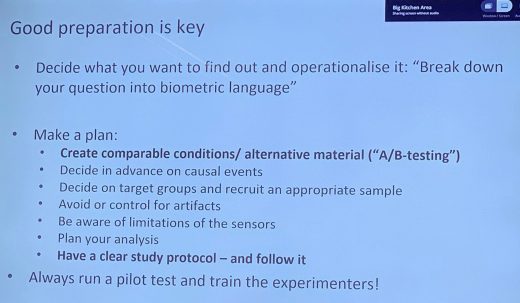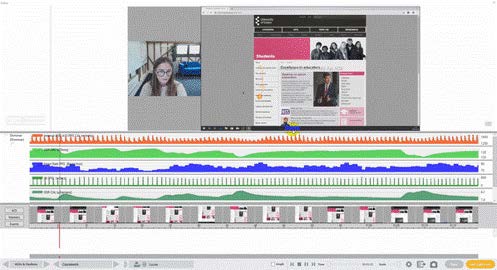In a previous blog, I discussed my recent experiences of the iMotions Academy training over in Copenhagen. Specifically, I ran through the more theoretical aspects of biometrics research, such as the different sensors available and the types of data they record. Read it here.
While the first half of the week was more theoretical, in the second half we were able to bring our newly learnt knowledge to life, creating our own study using the kit and getting to grips with the data outputs in an expert led, best practice environment.
Creating a study
One of the key takeaways from the week for me was the importance of study design. A study always starts with an overarching research question, but unless you are able to translate that into specific biometric language, then you run the risk of losing yourself in data and only gaining limited insights.
When tasked with creating a study, Funmi and I chose the booking journeys for a number of different airlines with an aim of finding out which was best. Obviously, ‘best’ isn’t really an objective metric, so we framed our study into biometric questions such as “which booking journey caused the most brow furrow?” (brow furrow being an indicator of cognitive load) or “which step in the journey caused the most negative emotion?” (based on the percentage of time that a participant shows negative emotional facial expressions during a stimulus). Armed with these types of questions, it was much easier to frame what the study would look like; what tasks we would set participants and the types of sensors we would use to collect the data.

The next step was designing the study. Understanding the different journeys and steps within each of the websites was vital, as was thinking about how we might incorporate survey questions into the study so that we could gain some self-report answers without interfering with the biometric data collection.
Another key aspect of the design was creating a study protocol for anyone running the study, so that changes to the conditions were kept to a minimum. A study protocol may cover everything from saying hello, to attaching the biometric sensors, to giving the initial instructions in a uniform manner; ultimately it is about creating a controlled environment from which to run the study.
Pilot studies and practical experience
A vital takeaway from the week was that, before undertaking a study, it is always sensible to run a pilot. A pilot is typically running a study with a handful of participants before the research day to identify aspects of the study which may not work properly, or to understand whether the study is going to provide the right types of data to make insights later on. Understandably, it is much better to identify and fix any issues with a study before you take it out into the wild.

With our pilot study complete, we were then able to begin data collection. In the absence of having access to a genuine sample of airline customers, we used other students at the academy and members of the iMotions team. In the real world however, we would do our best to gain a representative sample based on the client audiences or personas.
Analysing the data
With so many sensors at our disposal within biometric research, a huge amount of data is recorded in each study. The skill lies in identifying which data is going to give you the answers that you need to make actionable insights.

For our study, we focussed on metrics such as brow furrow to indicate cognitive load, overall negative emotion to indicate frustration, time on task as a measure of journey length and galvanic skin response (GSR) peaks per minute as a metric of emotional arousal. I will explore our experimental study in more detail in the final blog in this series.
Creating a study in an environment with experts was extremely helpful in ensuring best practices were followed. We built upon the principles of testing and research that we already used at Coast Digital, through learnings on the significance of context and additional detail, which will feed directly into our client projects now and in the future.
If you want to see how biometric research could be used for your organisation, or would like to discuss the potential for running your own biometric user experience study, please get in touch today.
